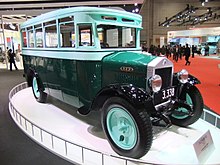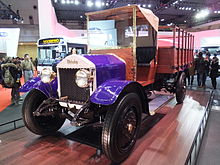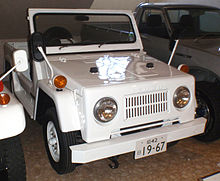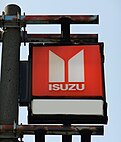Isuzu
Representative Director) | |
| Products | Commercial vehicles Diesel engines Diesel generators Passenger cars (until 2002)[1] |
|---|---|
| Revenue | |
| Total assets | |
| Total equity | |
Number of employees | 8,056 (44,495 consolidated) |
| Subsidiaries | |
| Website | www |
Isuzu Motors Ltd. (
The company also has a number of subsidiaries and joint ventures, including
Isuzu has assembly and manufacturing plants in
Named after the Isuzu River, the kanji of Isuzu (五十鈴) mean "fifty bells".
History


Isuzu Motors' history began in 1916, when Tokyo
In 1929
Etymology
The word Isuzu translated into English means "fifty bells"—hence the focus on "bell" in both the later Bellel and the Bellett. The name was used from the Isuzu River that flows near to the Ise Grand Shrine, one of Japan's most sacred and revered shrines.
Post World War history
Truck and bus production of the
Corporate partnerships
Beginning in 1953 the
Linking with General Motors
While the company had a long relationship with GM going back to the 1920s, the first investment of GM taking a 34% stake in Isuzu was seen in 1972, when the

In 1981 Isuzu began selling consumer and commercial vehicles under their own brand in the United States. The
Contraction begins

Isuzu ended US sales of the Impulse (Geo Storm) in 1992, and the following year it stopped exporting the Stylus (the basis for the Geo Spectrum), the last Isuzu-built car sold in the US.
In 1993 Isuzu began a new vehicle exchange program with
Isuzu's United States sales reached a peak in 1996 after the introduction of the
In 1998 GM and Isuzu formed DMAX, a joint venture to produce diesel engines. GM raised its stake in Isuzu to 49% the following year, effectively gaining control of the company, and quickly followed this up by appointing an American GM executive to head Isuzu's North American Operations. This marked the first time a non-Japanese executive had held such a high position at Isuzu. In 2001 GM and Isuzu announced plans to share distribution networks and for Chevrolet to market an Isuzu product.[15]

The production version of the VehiCROSS was introduced to the US in 1999, but met with mixed reviews, as its high price tag, unique styling and two-door configuration did not seem to meet with market demands. Production of the VehiCROSS and other sport utility vehicles, including the Trooper, ended in 2001 as part of a major financial reorganization which eliminated almost 10,000 jobs.[15] GM had been pushing the company to focus exclusively on producing commercial vehicles and engines.[15]
The number of Isuzu dealerships in the US began a rapid decline, and by 2005 had only 2 models: the Ascender (a re-badged GMC Envoy) and the i-series pickup truck (a rebadged Chevrolet Colorado). At this point, Isuzu in the US was primarily a distributor of medium duty trucks such as the
In early 2002, Fuji Heavy Industries (Subaru's parent company) bought Isuzu's share of Lafayette, Indiana plant, and Subaru Isuzu Automotive (SIA) became
Production of the 7-passenger Ascender ended in February 2006 with the closure of GM's Oklahoma City Assembly plant, leaving Isuzu with the 5-passenger Ascender, built in Moraine, Ohio and the low-selling i-Series as its only retail products. The company sold just 1,504 vehicles in North America in the first two months of 2006. GM ended its equity investment in Isuzu and sold all its shares to Mitsubishi Corporation, Itochu and Mizuho Corporate Bank; both GM and Isuzu claimed the companies would continue their relationship, but there was no word as of April 12, 2006 on the effect this would have on DMAX operations.


In June 2006 Isuzu and GM agreed to establish a joint venture called "LCV Platform Engineering Corporation (LPEC)" to develop a new pickup. Isuzu said it would use its engineering expertise to develop the pickup and GM would develop derivatives based on the integrated platform. Mitsubishi Corp became Isuzu's largest shareholder in October 2006, after it converted all the preferred shares in Isuzu it had held since 2005 into common stock, increasing its shareholding from 3.5% to 15.65%.[19]
In November 2006 Toyota purchased 5.9% of Isuzu, becoming the third largest shareholder behind Itochu and Mitsubishi Corporation, and the two companies agreed to study possible business collaboration focusing on the areas of R&D and production of diesel engines, related emissions-control, and other environmental technologies. In January 2007 Isuzu and General Motors updated the LCV range with a 3.0 litre common rail diesel engine that had far more torque and power than its predecessor. In August 2007 Isuzu and Toyota agreed to develop a 1.6-liter diesel engine for use in Toyota vehicles sold in European markets. At this point, details of development, production and supply of the diesel engine were still under discussion, but in principle, Isuzu would play the leading role, with production scheduled to begin around 2012.
On 30 January 2008, Isuzu announced its complete withdrawal from the US market,[20] effective 31 January 2009. It would continue to provide support and parts. The decision was due to lack of sales.[21] Some of the lack of sales was blamed on consumer experiences with low quality engines and service.[22] Isuzu had been experiencing a slow decline since the late 1990s. In less than 10 years, they had gone from selling a complete line of cars, trucks, and SUVs, into being a specialized SUV maker, and finally selling only a pair of rebadged, General Motors Trucks.[23] The company continued to sell commercial vehicles in the US.[24]
Isuzu and Toyota shelved development of a clean diesel engine in December 2008.[25]
On 29 January 2009, Isuzu and GM announced that they were in talks to transfer the operation of the medium-duty truck production line in Flint, Michigan to Isuzu for a five-year period. In June, however, GM announced that these talks failed to reach an agreement, and GM instead ceased production of the Chevrolet Kodiak and GMC Topkick vehicles on 31 July 2009.[26]
In July 2016, Isuzu and Mazda agreed to collaborate to produce the next-generation pickup trucks for Mazda outside of North America.[27] As a result, the third-generation Mazda BT-50 is built by Isuzu in Thailand since 2020.
Isuzu's plant in the Indian state of Andhra Pradesh began operations in 2016.[28]
In August 2018, Toyota sold off its 5.9% stake in Isuzu.[29]
In December 2019, Isuzu announced that it had signed a non-binding
In March 2021, Isuzu, Hino, and Hino's parent Toyota announced the creation of a strategic partnership between the three companies. Toyota acquired a 4.6% stake in Isuzu while the latter plans to acquire Toyota shares for an equivalent value. The three companies said they would form a new joint venture by April called Commercial Japan Partnership Technologies Corporation with the aim of developing fuel cell and electric light trucks. Toyota would own an 80% stake in the venture while Hino and Isuzu would own 10% each.[33]
Market presence



In most of Asia and Africa, Isuzu is known primarily for trucks of all sizes, after Isuzu dropped all sales of sedans and compact cars in the late 1990s due to plummeting sales. In the days when Isuzu sold passenger cars, they were known for focusing on the diesel-engined niche. In 1983, for instance, long before the explosion in diesel sales, diesels represented 63.4% of their passenger car production.[34] In 2009, Isuzu abandoned the United States consumer market due to lack of sales. Isuzu as a corporation has always been primarily a manufacturer of small to medium compact automobiles and commercial trucks of sizes medium duty and larger, but markets around the world show different needs.
Isuzu Motors America discontinued the sale of passenger vehicles in the United States on January 31, 2009. The company explained to its dealers that it had not been able to secure replacements for the
In Australia, Isuzu was for many years a major supplier of light commercial and domestic vehicles to Holden (General Motors). However, by 2008, Holden was sourcing few Isuzus. At this time Isuzu began to sell the D-Max under the Isuzu name.
Isuzu's entry in the Thai market proved to be one of its most successful. Its presence in the country began in 1966 when it established a manufacturing facility for pick-up trucks in the
Subsidiaries and joint ventures
Japan
The Fujisawa Plant was built and opened for production November 1961. It is located at 8 Tsuchidana,
Mimamori-kun online service
Mimamori-kun, which means to watch, monitor, or observe in
The service has been modified for personal use in Japan to keep track of family members, to include the health status of elderly persons and pinpoint the location of children for safety purposes.[40]
Some of the main features include the wireless Internet
International operations
- DMAX (engines) - former joint venture with General Motors in United States for production of diesel engines
- Ghandhara Industries- joint venture in Pakistan - trucks, buses
- Guangzhou Automobile Group Bus - joint venture in China - buses
- Industries Mécaniques Maghrébines - joint venture at Kairouan, Tunisia - trucks, SUVs
- Isuzu (Anadolu) - joint venture in Turkey - trucks, buses
- Isuzu Astra Motor Indonesia - joint venture in Indonesia - trucks, SUVs
- Isuzu HICOM Malaysia - joint venture in Malaysia - trucks, SUVs
- Isuzu Commercial Truck of America, Inc.
- Isuzu Motors de México - joint venture in Mexico - trucks, buses
- Isuzu Motors Saudi Arabia - joint venture in Saudi Arabia - trucks, SUVs
- Isuzu Motors (Thailand) - joint venture in Thailand - trucks, SUVs
- Isuzu Motorsports - Australia
- Isuzu Philippines - joint venture in the Philippines - trucks, SUVs
- General Motors De Portugal-FMAT S.A. at Tramagal near Abrantes (Assembling company of all Bedford and Isuzu medium to heavy diesel trucks and 4X4 Pickup models since the 1960s then vehicles are sent for sale in Portugal and Spain)
- The assembling of Isuzu commercial trucks is carried out by the Az Universal Motors which is part of the AzGroup in Azerbaijan.
- Isuzu Truck (UK)- at the former IBC factory Dunstable, England - trucks, SUVs
- Isuzu Truck South Africa- joint venture in South Africa - trucks
- Isuzu Vietnam - joint venture in Vietnam - trucks, SUVs
- Jiangxi Isuzu - joint venture in China - trucks, SUVs
- Qingling Motors - joint venture in China - trucks, SUVs
- Swaraj Mazda
- Sollers-Isuzu - joint venture in Russia - trucks (until July 2023[2])
- Thai Rung Union Car - Thailand - assembles SUVs
Former international operations
- Isuzu Motors Polska- former joint venture in Poland - diesel engines, taken over by General Motors
- Bosch
- Taiwan Isuzu Motors - former joint venture in Taiwan, disbanded in 2016 - trucks
Isuzu Diesel Engines / Power Train division
Diesel engines are a major part of the Isuzu Motor's business with over 20 million engines worldwide.[clarification needed][41] The diesel power division, known as the PowerTrain Division, of Isuzu Motors America, is located in Plymouth, Michigan.[41]
North American Master Distributors
Southwest Products[42] - Covering California, Nevada and Arizona.[42]
United Engines[42]
Mack Boring Parts[42]
M & L Engine[42]
Isuzu Diesel powered equipment
Ag Equipment
- Harrington Seed Destructor[43]
Construction equipment
- Paving equipment produced by CRAFCO. It manufacturers a variety of paving equipment that is powered by Isuzu diesel engines.[44]
Passenger, bus and commercial vehicles
This section needs additional citations for verification. (April 2020) |






Current passenger vehicles
- 2002–present, D-Max - pickup truck, a top selling diesel sold in the majority of Isuzu markets (excluding Japan and North America).
- 2013–present MU-X - SUV, successor of Isuzu MU-7, developed from D-Max.
Current commercial vehicles
- Como - light commercial van (rebadged Nissan Caravan)
- Elf - light duty truck (N-series)
- Erga - low deck heavy duty bus
- Erga-J- heavy duty bus
- Erga Mio - low deck medium duty bus
- Forward - medium duty truck (F-series)
- Giga - heavy duty truck (C-series, E-series)
- Gala - heavy duty bus
- Gala Mio - medium duty bus
- Journey - light duty bus
- Journey-J- medium duty bus
- Utilimaster Corporation.[45]
- Traga/Traviz - light commercial vehicle
UD Trucks vehicles
From April 2021 onwards, UD Trucks' products are part of the Isuzu company lineup.
Former passenger vehicles
- 1953–1962, Minx - sedan, Isuzu produced Hillman Minx under licence.
- 1961–1966, Bellel - sedan
- 1963–1973, Bellett - sedan (PR10/20) and coupe (PR90 and PR91)
- 1967–1983, Florian - sedan
- 1968–1981, 117- coupe
- 1972–2002, Faster - pickup truck
- 1974–2000, Stylus- sedan/coupe/hatchback
- 1981–1993,
- 1983–2002, Aska - sedan
- 1983–2002, Trooper - midsize SUV
- 1986–1993, Geminett - hatchback/wagon, a rebadged first generation Suzuki Cultus (1986–1988) and then third generation Subaru Leone wagon as Geminett II (1988–1993).
- 1989–2004, Amigo/MU - Compact SUV, renamed to Rodeo Sport in 2001.
- 1991–2004, Rodeo/Wizard - midsize SUV, also rebadged as the Honda Passport.
- 1996–1999, Oasis - minivan, a rebadged Honda Odyssey.
- 1996–2000, Chevrolet S10.
- 1996–2001, Honda Integra SJ.
- 1997–2002, Filly, a rebadged Nissan Elgrand - minivan
- 1999–2001, VehiCROSS - SUV
- 2001–2004, Axiom - midsize SUV
- 2002–2008, Ascender - midsize SUV, a rebadged GMC Envoy.
- 2006–2008, GMT355platform that Isuzu sells overseas.
- 2004–2013, MU-7 - midsize SUV, developed from D-Maxplatform that was on sale only in Thailand, Philippines, India and China.
- 1991–2020, Chevrolet Tavera.
Former commercial vehicles
- Bison - light commercial pickup truck, a rebadged second generation Mitsubishi Delica pickup truck for Indonesian market (not related to fourth generation Isuzu Elf that was sold under Bison name in Indonesia in the early 1990s).
- Fargo - light commercial van
- GMC Topkick and Chevrolet Kodiak).
Race cars
- 1969 Isuzu R7, Group 7- racecar
- 1970 Isuzu Bellett R6, Group 6- racecar
Concept cars
- 1969 Isuzu Bellett MX1600
- 1979 Isuzu Asso di Fiori
- 1983 Isuzu COA
- 1985 Isuzu COA II
- 1987 Isuzu COA III, AWD mid-engine coupe.
- 1987 Isuzu Zero Door
- 1989 Isuzu Costa
- 1989 Isuzu MultiCROSS
- 1989 4200R
- 1991 Isuzu Como F1, a rebadged Nissan Caravanproduced from 2001).
- 1991 Isuzu Nagisa
- 1991 Isuzu Terraza
- 1993 Isuzu XU-1
- 1993 Isuzu VehiCROSS
- 1995 Isuzu Deseo
- 1995 Isuzu Aisance
- 1997 Isuzu VX-2
- 1997 Isuzu ZACCAR
- 1999 Isuzu VX-O2
- 1999 Isuzu Kai
- 1999 ZXS
- 2000 Isuzu VX-4
- 2001 Isuzu Zen
- 2001 Isuzu GBX
- 2001 Isuzu Axiom XSF
- 2002 Isuzu Axiom XSR
- 2002 Isuzu Axiom XST
- 2011 Isuzu T-Next
- 2020 Isuzu FLIR
Buses (Philippines)
- LV314K
- LV314L
- CJM470
- CJM500
- LT132
- LV423
- LV123
- PABFTR33PLB
- FTR33P
- FTR45
- PABFVR33P
Buses (Thailand)
- CQM275hp
- CQA650A/T
- JCR600YZNN
- LT112P
- LV223S
- LV423R
- LV486R
- LV771
- MT111L
- MT111QB
Buses (Ukraine)
- Bogdan buses - sold under Isuzu brand outside Ukraine
Military vehicles

- Isuzu TW340 medium truck
- Isuzu TWD20/25 medium truck
- Isuzu TSD45/TSD55 medium truck
- Isuzu HTS12G 2.5 ton truck
- Isuzu Type 73 Heavy Truck
See also
References
- ^ Jackson, Kathy (4 February 2008). "Isuzu's collapse". Automotive News. Crain Communications, Inc. Archived from the original on 10 October 2019.
- ^ a b "Из России ушел еще один японский автопроизводитель". Banki.ru (in Russian). 14 July 2023.
- ^ ISBN 0-517-61777-3.
- ^ "Isuzu Website". Archived from the original on 5 May 2017. Retrieved 25 May 2017.
- ^ ISBN 978-4-86396-183-8.
- ^ "Investor Relations: Company History". Isuzu Motors. Archived from the original on 20 April 2012. Retrieved 28 August 2012.
- ^ Ishikawa, p. 7
- ^ Yamaguchi, Jack (February 1968). "14th Tokyo Motor Show: & Still Trying Harder". Road & Track. p. 113.
- ^ "Isuzu" (brochure) (in Japanese). Isuzu Motors. October 1967: 8–9. 42.10.
{{cite journal}}: Cite journal requires|journal=(help) - ^ a b Ruiz, p. 131
- ISBN 978-1-921295-17-1.
- ^ Nihon Keizai Shimbun. Tokyo: 1. 18 August 1981.
- Nihon Keizai Shimbun. Tokyo: 10. 18 January 1986.
- ^ Truett, Richard Truett (21 October 1993). "Expert Reviews: 1993 Isuzu Rodeo". Orlando Sentinel. Archived from the original on 23 September 2015. Retrieved 4 October 2015.
- ^ a b c Krebs, Michelle (1 July 2001). "Isuzu's U.S. Presence Leans on G.M." The New York Times. Archived from the original on 24 September 2017. Retrieved 23 September 2017.
- ^ a b c "Isuzu falls back after GM rescue plan". CNN.com. 15 August 2002. Archived from the original on 24 September 2017. Retrieved 23 September 2017.
- ^ "Press Release: Isuzu Motors Limited Unveils the New Three-year Business Plan and Re-capitalization Plan, involving Decrease of Capital and Debt-for-equity Conversion". www.Isuzu.co.jp. Isuzu Motors. Archived from the original on 24 September 2017. Retrieved 23 September 2017.
- ^ Belson, Ken (15 August 2002). "G.M. Moves to Increase Control of Some Isuzu Units". The New York Times. Archived from the original on 24 September 2017. Retrieved 23 September 2017.
- ^ "Mitsubish becomes top shareholder of Isuzu". Autoblog. Archived from the original on 8 May 2016. Retrieved 26 April 2016.
- ^ Bensinger, Ken (31 January 2008). "Isuzu quitting U.S. car market". Los Angeles Times. Archived from the original on 31 January 2008. Retrieved 30 January 2008.
- ^ a b Johnson, Drew (30 January 2008). "Isuzu to leave U.S. market". Leftlanenews.com. Archived from the original on 13 March 2012. Retrieved 5 February 2012.
- ^ "Consumer complaints about Isuzu - Engine Failure". Consumeraffairs.com. Archived from the original on 16 January 2012. Retrieved 5 February 2012.
- ^ Neff, John (30 January 2008). "CONFIRMED: Isuzu abandoning U.S. market". Autoblog. Archived from the original on 18 November 2010. Retrieved 29 November 2010.
- ^ "Isuzu executive says competition helped push it out of North American market - MSNBC Wire Services - MSNBC.com". Cnbc.com. Retrieved 29 November 2010. [dead link]
- ^ "Isuzu, Toyota Shelve Development of Clean Diesel Engine | industryweek.com | Industry Week". industryweek.com. 16 December 2008. Archived from the original on 23 June 2013. Retrieved 21 May 2011.
- ^ "GM drops medium-duty trucks, opens battery lab". The Detroit News. 9 June 2009. Retrieved 4 December 2009.
- ^ Counts, Reese (11 July 2016). "Mazda and Isuzu to collaborate on a new pickup truck". Autoblog.
- ^ Isuzu Motors opens manufacturing plant in Andhra Pradesh Archived 2017-01-05 at the Wayback Machine, Economic Times, April 27, 2016
- ^ Isuzu and Toyota to Dissolve Capital Ties
- ^ "Isuzu to buy Japanese truck unit from Volvo in $2.3 billion deal". Japan Times. 19 December 2019.
- ^ De Guzman, Marcus (1 December 2020). "Isuzu and Volvo have finalized the terms of their alliance". Auto Industriya. Retrieved 14 December 2020.
- ^ "Isuzu Completes Acquisition of UD Trucks". Heavy Duty Trucking. 1 April 2021. Retrieved 6 April 2021.
- ^ "Toyota and Isuzu to take stake in each other to co-develop new vehicles". Japan Times. 25 March 2021. Retrieved 6 April 2021.
- )
- ^ "Company Info - Budget Truck Rental". Budgettruck.com. 30 December 2007. Archived from the original on 22 July 2007. Retrieved 29 November 2010.
- ^ ISBN 9789814324113.
- ^ "Isuzu interim profit seen climbing 7% as Thai sales recover". Nikkei Asian Review. 3 November 2017. Archived from the original on 17 August 2018. Retrieved 17 August 2018.
- from the original on 17 August 2018. Retrieved 17 August 2018.
- ^ "Official press release from Isuzu concerning Mimamori-kun". Archived from the original on 19 October 2015. Retrieved 16 August 2015.
- ^ "Mimamori-kun personal service (Japanese)". Archived from the original on 19 October 2015. Retrieved 16 August 2015.
- ^ a b "Isuzu Diesel Engines - Home". www.isuzuengines.com. Archived from the original on 22 October 2016. Retrieved 21 October 2016.
- ^ a b c d e "Isuzu Diesel Master Distributor List" (PDF). www.isuzuengines.com. Archived (PDF) from the original on 12 October 2016.
- ^ "Case Study - Isuzu Diesel Engines". isuzudiesel.com.au. Archived from the original on 22 October 2016. Retrieved 21 October 2016.
- ^ "Pavement Preservation & Maintenance Equipment Documents | CRAFCO". www.crafco.com. Archived from the original on 22 October 2016. Retrieved 21 October 2016.
- ^ InsideINdianaBusiness.com Report. "Indiana Facility to Produce Isuzu Commercial Vehicles - Newsroom - Inside INdiana Business with Gerry Dick". Insideindianabusiness.com. Archived from the original on 22 February 2015. Retrieved 5 February 2012.
{{cite web}}:|author=has generic name (help) - ^ "1991 Isuzu Como". www.carstyling.ru. 2 July 2007. Archived from the original on 11 June 2011. Retrieved 29 November 2010.



